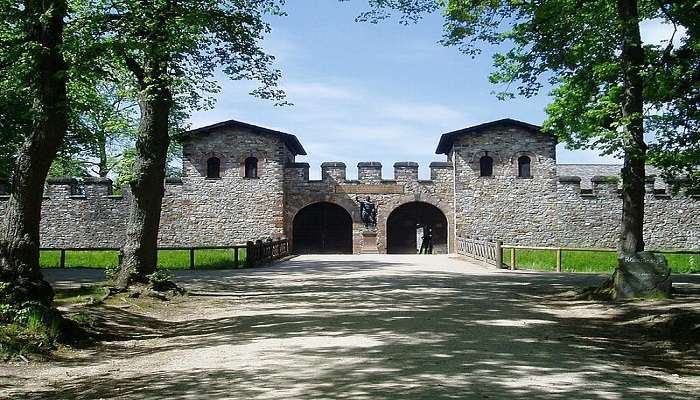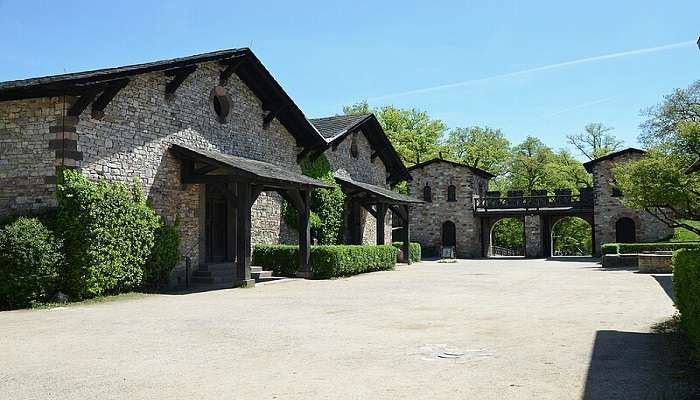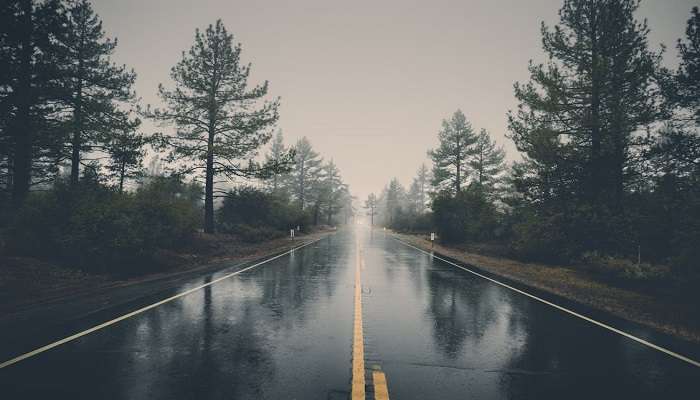Explore The Ancient Roman Fort Of Saalburg On Your Next 2026 Germany Trip

Located in the Taunus mountains near Frankfurt, Germany, lies a remarkable example of Roman engineering and military prowess, the Saalburg. This reconstructed Roman fort stands as a living museum, offering visitors a unique glimpse into life on the frontiers of the Roman Empire. Once part of the Limes Germanicus, the northern border fortification system, Saalburg guarded the Empire against Germanic tribes. Today, it is an archaeological park and research centre, meticulously restored to its former glory. From its imposing gates to the detailed exhibits within, Saalburg invites modern-day explorers to step back in time and experience the daily life of Roman soldiers and civilians on the edge of the empire.
About Saalburg

The Saalburg is a fascinating Roman fort situated on the main ridge of the Taunus mountains, northwest of Bad Homburg in Hesse, Germany. This cohort fort is integral to the Limes Germanicus, the extensive Roman border fortification that once protected the German provinces. The Saalburg stands out as Germany’s most thoroughly reconstructed Roman fort, offering a unique glimpse into ancient Roman military architecture and daily life.
Conveniently located off the main road between Bad Homburg and Wehrheim, it has been recognised as part of the UNESCO World Heritage site since 2005 under the Upper Limes designation. In the modern numbering system for the Limes, it is identified as ORL 11. The Saalburg serves as a historical monument and an educational site, providing valuable insights into the Roman Empire’s presence in Germany.
Also Read: Munich In January
History Of Saalburg

Around AD 90, a simple wood-and-earth fort was constructed at Saalburg to house a numerous unit of auxiliary troops consisting of about 160 men. In the late reign of Hadrian, around AD 135, the numerus fort was replaced with a much larger fort for a cohort, a unit of about 500 men. This new fort, covering 3.2 hectares, was reoriented to face the growing Roman city of Heddernheim. Initially, the fort had dry-built wood-and-stone walls, later replaced with mortared stone walls and an earthen ramp in the second half of the 2nd century.
The cohort had initially been stationed at Aquae Mattiacorum (Wiesbaden), then moved to the Butzbach fort, and finally to Saalburg. The fort remained in this form and with this occupancy until the fall of the German limes around AD 260. During this period, the name of the unit and some of its commanders are repeatedly mentioned in stone inscriptions. In the early 3rd century, the situation along the limes became increasingly unsettled. A preventive war under Caracalla in AD 213 temporarily reduced Germanic pressure on the border. The town of Nida was given a defensive enclosure around this time.
However, by around 233, the Alemanni entered Roman territory again, with further major incursions occurring in 254 and 260. Eventually, all areas east of the Rhine were lost during the major political and economic crisis of the mid-3rd century. During these events, the Saalburg fort appears to have been abandoned deliberately and without military action. After the abandonment of the Upper Germanic Limes, the fort was used as a quarry.
Architecture Of Saalburg

The Saalburg, in its final architectural phase, as reconstructed today, is a cohort fort typical of this part of the limes. It is a 147 by 221-meter rectangle with four gates. The 3.25-hectare (8.0 acres) has a double ditch and a mortared defensive wall enclosed interior. The external face of the wall was whitewashed and painted with a trompe-l’œil pattern of ashlar blocks. On the inside, an earthen ramp was placed along the length of the wall to enable defenders to access the top. The corners were rounded and not crowned with towers, but all four gates were flanked by two towers each.
The fort was oriented so that its main gate, or porta praetoria, faced south-south-east, away from the limes but towards Nida. The central structure of the fort was a large principia, a central plaza surrounded by housing or offices for the higher officers, flanked by a roofed hall for assemblies of the fort’s garrison. The praetentura (front part of the fort) contained the praetorium (the fort commander’s residence) to the west of the via praetoria and a large horreum (grain store) to its east.
The rest of the fort’s interior, now a park-like area of grass and trees, should be visualised as packed with further buildings: stables, magazines, workshops, and troop quarters subdivided into contubernia. Two such troop barracks have been reconstructed in the southeast part of the fort. For the general arrangement and terminology of Roman fort architecture, see Castra.
Related Post: Waterfalls In Munich
Opening Hours And Entrance Fees

The Saalburg Roman Fort is open throughout the year, with summer hours (March to October) from 9 AM to 6 PM daily and winter hours (November to February) from 9 AM to 4 PM, Tuesday to Sunday (closed on Mondays).
Entrance fees are €8 for adults, €6 for reduced tickets, €3 for children aged 6-17, and free for children under 6. During the summer, the fort hosts various programs where museum supporters dress up as Roman soldiers, offering an immersive historical experience. The grounds are ideal for picnics and hiking, with the Rundweg Saalburg trail being popular.
Best Time To Visit

The best time to visit the Saalburg Roman Fort in Germany is from May to September, during the late spring to early autumn months. The weather is generally mild and pleasant during this period, making it ideal for exploring the outdoor exhibits and the surrounding Taunus forest.
Additionally, the fort hosts various events and reenactments during these months, providing a more immersive historical experience. Visiting during these months ensures you can fully enjoy the site’s rich history and natural beauty.
Related Post: Munich Lakes
How To Reach Saalburg?

Visitors can choose from several transportation options to reach Saalburg, a historical Roman fort located near Bad Homburg in Germany. To reach Saalburg, here are a few ways:
By Air
The nearest major airport to Saalburg is Frankfurt Airport (FRA). From Frankfurt, you can take a combination of travellers who have to use trains and buses to get to Saalburg. The journey is from Frankfurt by train to Erfurt and then by train to Saalfeld (Saale), by bus to Bad Lobenstein and by bus to Saalburg. This route can be described as a rather beautiful drive through the countryside of Germany.
By Train
A train is among the most comfortable means of transport to Saalburg. It is also possible to get a train from other cities, such as Frankfurt or Berlin, and get down to Erfurt. After reaching Erfurt, one has to change to a train going to Saalfeld (Saale). After arriving in Saalfeld, it is possible to take a regional train to Bad Lobenstein and then a bus to Saalburg. The train ride is very comfortable, and the scenery is very picturesque.
By Road
Another means of transport is by road. If you are interested in driving, you can get to Saalburg by road. The town has a good network of highways and roads available for different transport services. Saalburg can be accessed by taking the A5 and A4 highways from Frankfurt. The drive will take roughly 3-4 hours, depending on the traffic jam that may occur in the middle of the journey. Driving enables one to move around beautiful areas and make a stop wherever he or she wants.
By Bus
Other means of transport to Saalburg include a bus, which can also be from other cities. Another way is to go by bus, from Frankfurt or Berlin to Erfurt, and then take a regional transport bus to Saalburg. The bus ride is cheap, and during the journey, there is time to admire the beauty of the countryside.
You May Also Like To Read: Museums In Frankfurt
Saalburg is a unique opportunity to get acquainted with the Roman period and feel like you were in the ancient empire. With its reconstructed structures and the artefacts displayed at the site, this UNESCO World Heritage site is a great place for history lovers and tourists. Ready for your own Roman adventure? Book yourtrip to Europe today and make Saalburg a must-see destination on your itinerary. Discover the wonders of ancient Rome right in the heart of modern Germany!
For our editorial codes of conduct and copyright disclaimer, please click here.
Cover Image Credit: Ekem for Wikimedia Commons
Frequently Asked Questions About Saalburg
Can I take photos at Saalburg Roman Fort?
Yes, photography is allowed at Saalburg, both inside the museum and throughout the reconstructed fort. However, flash photography might be restricted in certain areas where artefacts are displayed.
What kind of events are held at Saalburg?
Saalburg hosts various events throughout the year, including reenactments, Roman festivals, and educational programs. Visitors can experience Roman military drills, ancient crafts, and themed activities for all ages.
Can Saalburg be visited in winter?
Saalburg is open year-round, although hours may vary during the winter season. Some outdoor areas may be more challenging to explore in colder months, so visitors should dress accordingly.
Does Saalburg offer educational programs for schools?
Yes, Saalburg offers a range of educational programs designed for school groups. These programs provide interactive learning experiences, including hands-on activities, guided tours, and demonstrations of Roman life.
Are pets allowed at Saalburg?
Pets are not allowed inside the museum or reconstructed fort areas, except for service animals. However, visitors can explore the grounds and trails with their pets on a leash.
People Also Read:
Red Fort Mehrangarh Fort Agra Fort

With a passion for travelling, and carving beautiful stories of stunning locations I chose my profession as a content writer. The unique blend of creativity and strategy ensures that each narrative takes readers on a journey to their desired destination. With distinct locations and unique vibes, I strive to deliver captivating content that speaks to the hearts of readers.











